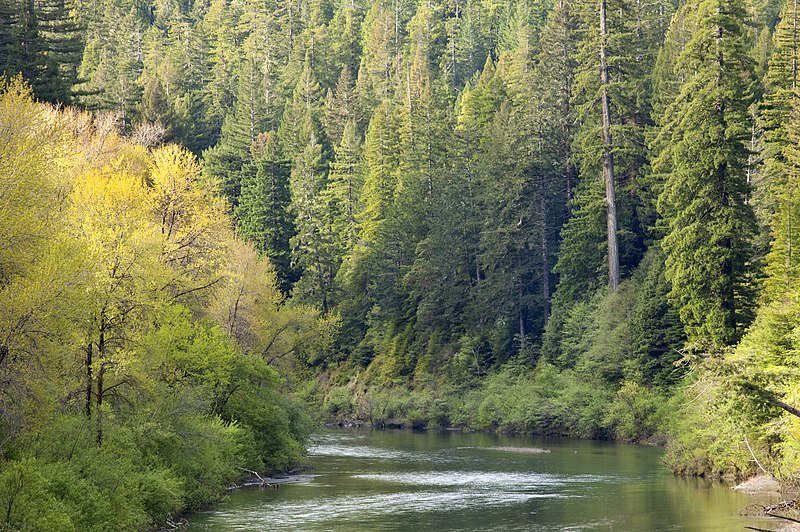PG&E may be dammed with Eel River safety concerns
/courtesy// commons.wikipedia.org
On April 18, national conservation organization American Rivers released their report “America’s Most Endangered Rivers of 2023,” and listed Northernwestern California’s Eel River as being the sixth most endangered river in the U.S.A. American River publishes this list every year, and judges the state of different rivers based upon criteria including the river’s significance to people and nature, the magnitude of the threats presented to the watershed and surrounding communities, and how the public can influence decisions impacting the river’s future.
The Eel River is the third largest in California, stretching for 3,684 square miles, flowing northward from the coast ranges west of the Sacramento Valley before dumping into the Pacific Ocean on the coast of Humboldt County. Historically, the river has been one of the most productive and diverse fisheries within California, supporting a wide and assorted array of native fish species, by part thanks to the high elevation and cool waters of the Eel River’s headwaters.
The reason behind the Eel River’s place within the American Rivers’ List has to do with the construction of the Scott and Cape Horn Dams in 1922 and 1908 respectively, as a part of the Porter Valley Project. Both dams divert water from the Eel River towards the Russian River down south and have been linked towards the delayed recovery of multiple critically endangered fish species. These include federally protected species, as well as habitat destruction and environmental pollution, and the loss of culturally and economically significant fish runs for indigenous communities. Recovering fish populations have also taken a heavy blow. The dams completely block native fish migration patterns and access to spawning grounds, such as 89 miles of Chinook salmon and 288 miles of steelhead trout spawning habitat, both of which have been blocked off by the dams.
The dams impact not just the native wildlife and surrounding habitat, but also affects multiple local tribal nations and indigenous communities. The Eel River has long been the ancestral homeland of several indigenous peoples, including the Yuki, Wailaki, Sinkyone, Wiyot, Catho, Pomo, Lassik, and Nongatl, as well as other nations that were forcibly relocated to the area during the early 20th century. Many of these peoples continue to live alongside the river and the surrounding areas, as well as maintaining the river's health, as it holds massive cultural significance, and is also used for sustenance.
In addition to environmental effects, there have also been numerous safety concerns surrounding the two over 100 year-old dams. Scott Dam is one of the 1,680 dams across the U.S.A that have been treated as a high hazard facility, meaning that loss of life is possible in the event of dam failure, which is not too far from reality, given that California is known for being a well known hotbed for seismic activity. On March 16, the Pacific Gas and Electric Company (PG&E) announced that Scott Dam’s spillway gates will be open going forward, starting this spring, due to the potential and devastating outcomes for downstream communities, especially when the impounded Lake Pillsbury reservoir is at full capacity.
Because of the problems presented, PG&E planned to decommission the Porter Valley Project in July 2022, surrendering their license to operate both dams. Even with this massive opportunity, based on American River’s list, the decommission and removal process is becoming a slow one. According to American Rivers, the next steps PG&E must take to restore the Eel River and its communities include “removing both dams, repairing the damage they have caused, and ensuring the safety of downstream communities. They must also take immediate steps to reduce the impacts to already struggling fish populations caused by the current operation of the dams.'' American Rivers also says if PG&E is unwilling to commit, the Federal Energy and Regulation Commission (FERC) should hold them accountable and further request the full removal of Scott and Cape Horn.
In addition, the removal of both dams would result in the Eel River becoming California’s longest free-flowing river.
However, these calls to action do not remain unopposed, mainly from residents who rely upon the Russian River watershed. Even though urban water providers such as Sonoma Water will still have access to the same water if the plans go through and the water is diverted towards Lake Mendocino, people who still rely on the Russian River could expect to lose their right to withdraw from the Russian River for the time being. The low water flow also means the temporary suspension of an agreement on Russian River water sharing agreement, which permitted participants with older “senior” water rights to share water allotments with those whose rights have been lost. In addition, there is not enough water in the system for people to share their own water supplies, let alone supply themselves.



